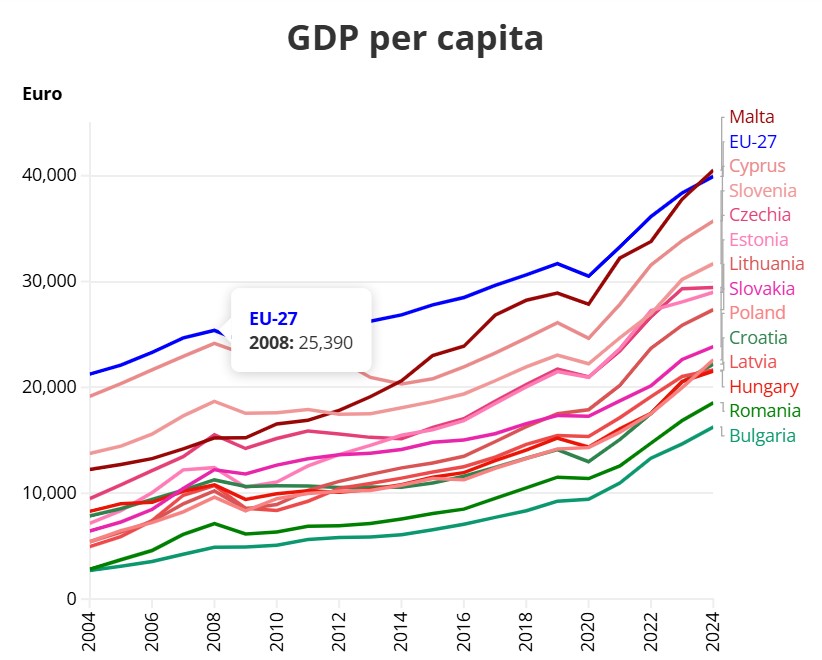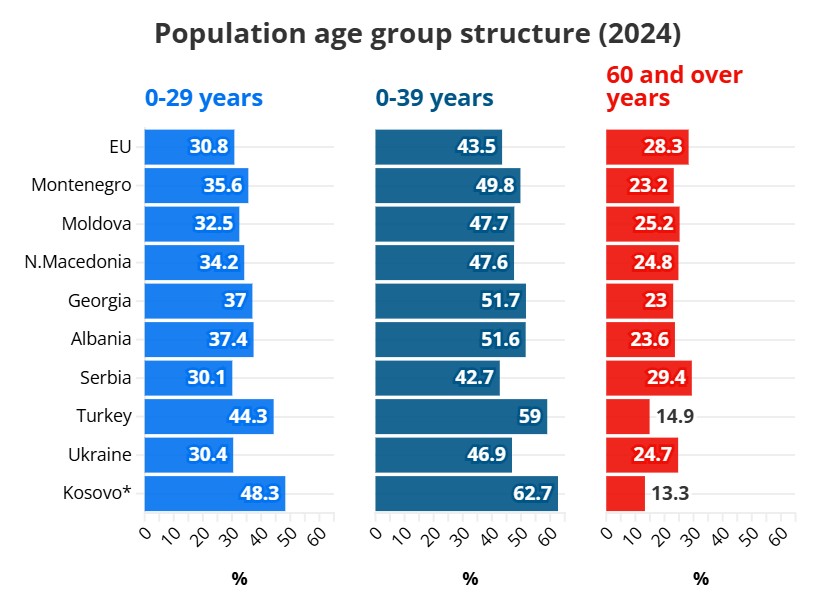Today, support for further EU enlargement is higher than ever. This is backed by positive economic data from the countries that joined the eurozone relatively recently — in 2004.
According to Eurobarometer, 74% of EU citizens believe that membership in the bloc has benefited their country. These figures come from a survey conducted at the beginning of 2025. Experts note that this is the highest level of support since such questions were first asked in 1983.
Respondents pointed to economic growth (28%) and employment opportunities (26%) as the main benefits.
In the Czech Republic, GDP per capita increased from 45% to 74% of the EU average between 2004 and 2024 — rising in monetary terms from €9,490 to €29,940. In Lithuania, GDP per capita rose from 26% to 68% of the EU average over the same period, increasing from €4,960 to €27,350.

Fivefold Growth
Over the last 20 years, while GDP per capita in the European Union as a whole increased by an average of 88% — with the prosperity index rising from 100 to 188 points — the jump in the 13 newer member states has been even more remarkable. Romania and Bulgaria have shown the strongest growth, at 558% and 500% respectively, with the index reaching 600 points in both countries.
During this period, GDP per capita rose in Romania from €2,820 to €18,560, and in Bulgaria from €2,710 to €16,260.
Over the past two decades, similarly impressive trends have been observed in the Baltic states: GDP per capita increased by 405% in Lithuania, 336% in Latvia, and 305% in Estonia.

Growth in Purchasing Power
The Purchasing Power Standard (PPS) is an additional indicator used to assess the dynamics of economic growth in new EU member states.
If we take Romania and Bulgaria as examples, both had the lowest scores in 2004 (35 points), which was 65% below the EU average. However, two decades later, Romania’s purchasing power has doubled, reaching 78 points, while Bulgaria’s has risen to 66.
In Lithuania, the index increased from 50 to 88; in Latvia, from 45 to 71; in Poland, from 52 to 79; and in Estonia, from 56 to 79.
More modest growth was recorded in Slovenia — from 87 to 91 — and in the Czech Republic — from 81 to 91.
The European Commission maintains that the 2004 enlargement “brought significant benefits and impressive economic growth to both the new members and the EU as a whole.”
How Large Are the Economies of the Candidate Countries?
Currently, nine countries hold EU candidate status: Bosnia and Herzegovina, Montenegro, North Macedonia, Albania, Serbia, Ukraine, Moldova, Georgia, and Turkey, plus one potential candidate — Kosovo.
In April, the EU Commissioner for Enlargement, Marta Kosma, stated that a new accession round by 2030 is “realistic,” led by Ukraine, Moldova, Albania, and Montenegro.
In terms of GDP, these are relatively small economies.
According to Eurostat, in 2024 the total output of the European Union amounted to €18 trillion. The 10 candidate countries together accounted for €1.63 trillion — of which Turkey alone represented €1.25 trillion.
If Turkey is excluded, the remaining nine candidate countries produced only €381 billion — which is less than the GDP of Denmark alone.
Europe Is Aging
Can Enlargement Bring New Life?
The population of the European Union is expected to peak in 2026 at 453 million, after which it will begin to gradually decline. According to Eurostat projections, if migration were to fall to zero, the EU’s population would decrease by 34% by the year 2100 — a change that would significantly affect the labor force.
Recent data shows that without migration, the EU population would shrink by one-third by the end of the century, with the Union losing around 1 million workers every year over the next 25 years, as Italy and Spain face the risk of demographic collapse.
Eurostat forecasts that if migration were halted entirely, the EU population would decline by around 9% by 2050 compared to 2025. The decrease would likely continue in the following decades, reaching 23% by 2075 and 34% by 2100.
If labor force participation rates by age and gender remain at the average levels observed between 2011 and 2022, the labor force would shrink by 20.2% by 2070. According to a report from the European Commission’s Joint Research Centre (JRC), this would mean the loss of approximately 42.8 million workers. In less favorable scenarios, the decline could be even sharper — up to 26.7%, or 55.9 million workers.
JRC researchers emphasize that “migration may play a decisive role in shaping the EU labor market in the coming decades, especially if migrants are successfully employed and integrated into the workforce.”
Several studies have examined how potential EU enlargement could help address the projected labor shortages. The European Commission notes that the historic enlargement of 2004 brought substantial benefits and strong economic growth not only to the new member states but to the EU as a whole.
Eurostat projections clearly show that EU member states will experience a sharp decline in population over the coming decades, continuing until 2100.
If we take the EU population in 2025 as 100 people, this number is expected to fall to 91 by 2050, 77 by 2075, and 66 by 2100. In other words, over the next 75 years, one out of every three people will disappear.

Overall, the populations of EU candidate countries are younger than those of EU member states—with the exceptions of Serbia and Ukraine. According to Eurostat, in 2024, 30.8% of the EU population was under the age of 29. Only Serbia (30.1%) and Ukraine (30.4%) slightly exceeded this share.
The other seven candidate countries have significantly younger populations: in Turkey (44.3%) and Kosovo (48.3%), the share of young people exceeds 40%.
A recent report by the Carnegie Foundation notes that “candidate countries, much like much of Central and Eastern Europe, are also experiencing population decline and labor shortages.”
The European Commission cites the historic 2004 enlargement as an example of successful expansion: “Over the past 20 years, both the European Union and the newly joined countries have experienced growth and increased prosperity.”
Based on materials from Euronews and Eurostat statistical data.

